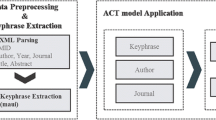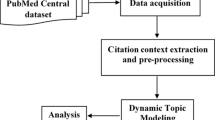Abstract
The purpose of this paper was to analyze the intellectual structure of biomedical informatics reflected in scholarly events such as conferences, workshops, symposia, and seminars. As analysis variables, ‘call for paper topics’, ‘session titles’ and author keywords from biomedical informatics-related scholarly events, and the MeSH descriptors were combined. As analysis cases, the titles and abstracts of 12,536 papers presented at five medical informatics (MI) and six bioinformatics (BI) global scale scholarly event series during the years 1999–2008 were collected. Then, n-gram terms (MI = 6,958; BI = 5,436) from the paper corpus were extracted and the term co-occurrence network was analyzed. One hundred important topics for each medical informatics and bioinformatics were identified through the hub-authority metric, and their usage contexts were compared with the k-nearest neighbor measure. To research trends, newly popular topics by 2-year period units were observed. In the past 10 years the most important topic in MI has been “decision support”, while in BI “gene expression”. Though the two communities share several methodologies, according to our analysis, they do not use them in the same context. This evidence suggests that MI uses technologies for the improvement of productivity in clinical settings, while BI uses algorithms as its tools for scientific biological discovery. Though MI and BI are arguably separate research fields, their topics are increasingly intertwined, and the gap between the fields blurred, forming a broad informatics—namely biomedical informatics. Using scholarly events as data sources for domain analysis is the closest way to approximate the forefront of biomedical informatics.
Similar content being viewed by others
References
Andrews, J. E. (2003). An author co-citation analysis of medical informatics. Journal of the Medical Library Association, 91(1), 47–56.
Bansard, J. Y., Rebholz-Schuhmann, D., Cameron, G., Clark, D., van Mulligen, E., Beltrame, E., et al. (2007). Medical informatics and bioinformatics: A bibliometric study. IEEE Transaction on Information Technology in Biomedicine, 11(3), 237–243.
Callon, M., Courtial, J., & Laville, F. (1991). Co-word analysis as a tool for describing the network of interactions between basic and technological research: The case of polymer chemistry. Scientometrics, 22(1), 155–205.
Callon, M., Courtial, J.-P., Turner, W. A., & Bauin, S. (1983). From translations to problematic networks: An introduction to co-word analysis. Social Science Information, 22(2), 191–235.
David, F. (2005). Introduction to bioinformatics. Journal of the American Society for Information Science and Technology, 56(5), 440–446.
Fuller, S., Revere, D., Bugni, P., & Martin, G. (2004). A knowledgebase system to enhance scientific discovery: Telemakus. Biomedical Digital Libraries, 1(1), 2.
Garfield, E. (1986). Mapping the world of biomedical engineering: Alza lecture (1985). Annals of Biomedical Engineering, 14(2), 97–108.
Glänzel, W., Schlemmer, B., Schubert, A., & Thijs, B. (2006). Proceedings literature as additional data source for bibliometric analysis. Scientometrics, 68(3), 457–473.
Godin, B. (1998). Measuring knowledge flows between countries: The use of scientific meeting data. Scientometrics, 42(3), 313–323.
Greenes, R. A., & Shortliffe, E. H. (1990). Medical informatics. An emerging academic discipline and institutional priority. JAMA, 263(8), 1114–1120.
Hasman, A., & Haux, R. (2006). Modeling in biomedical informatics—an exploratory analysis (part 1). Methods of Information in Medicine, 45(6), 638–642.
Hasman, A., & Haux, R. (2007). Modeling in biomedical informatics: An exploratory analysis part 2. International Journal of Medical Informatics, 76(2–3), 96–102.
Hasman, A., Haux, R., & Albert, A. (1996). A systematic view on medical informatics. Computer Methods and Programs in Biomedicine, 51(3), 131–139.
He, Q. (1999). Knowledge discovery through co-word analysis. Library Trends, 48(1), 133–159.
Jeong, S., Lee, S., & Kim, H.-G. (2009). Are you an invited speaker? A bibliometric analysis of elite groups for scholarly events in bioinformatics. Journal of the American Society for Information Science and Technology, 60(6), 1118–1131.
Kleinberg, J. (1999). Authoritative sources in a hyperlinked environment. Journal of the ACM, 46(5), 604–632.
Kranakis, E., & Leydesdorff, L. (1989). Teletraffic conferences: Studying a field of engineering science. Scientometrics, 15(5), 563–591.
Lisacek, F., Chichester, C., Kaplan, A., & Agnes, S. (2005). Discovering paradigm shift patterns in biomedical abstracts: Application to neurodegenerative diseases. Paper presented at the first international symposium on semantic mining in biomedicine.
Lisée, C., & Larivière, V. (2008). Conference proceedings as a source of scientific information: A bibliometric analysis. Journal of the American Society for Information Science and Technology, 59(11), 1776–1784.
Luscombe, N. M., Greenbaum, D., & Gerstein, M. (2001). What is bioinformatics? A proposed definition and overview of the field. Methods of Information in Medicine, 40(4), 346–358.
Malin, B., & Carley, K. (2007). A longitudinal social network analysis of the editorial boards of medical informatics and bioinformatics journals. Journal of American Medical Informatics Association, 14(3), 340–348.
Mane, K. K., & Börner, K. (2004). Mapping topics and topic bursts in PNAS. Proceedings of the National Academy of Sciences of the United States of America, 101, 5287–5290.
Mann, G. S., Mimno, D., & McCallum, A. (2006). Bibliometric impact measures leveraging topic analysis. Paper presented at the 6th ACM/IEEE-CS joint conference on digital libraries.
Maojo, V., & Kulikowski, C. A. (2003). Bioinformatics and medical informatics: Collaboration on the road to genomic medicine? Journal of American Medical Informatics Association, 10(6), 515–522.
Martens, B., & Saretzki, T. (1993). Conferences and courses on biotechnology. Describing scientific communication by exploratory methods. Scientometrics, 27(3), 237–260.
Martens, B., & Saretzki, T. (1994). Quantitative analysis of thematic structures in the field of biotechnology: A study on the basis of conference data. Scientometrics, 30(1), 117–128.
Matsuo, Y., Tomobe, H., Hasida, K., & Ishizuka, M. (2003). Mining social network of conference participants from the web. In Proceedings of the international conference on web intelligence (pp. 190–194).
McCain, K. W. (1991). Core journal networks and cocitation maps: New bibliometric tools for serials research and management. Library Quarterly, 61(3), 311–336.
McCain, K. W. (1995). Biotechnology in context: A database-filtering approach to identifying core and productive non-core journals supporting multidisciplinary R & D. Journal of the American Society for Information Science, 46(4), 306–317.
McCain, K. W., & Silverstein, S. M. (2007). Tracing persistent highly visible research themes in medical informatics. Paper presented at the 2006 AMIA spring congress. Retrieved from http://hdl.handle.net/1860/1594.
Morris, T. A. (2000). Structural relationships within medical informatics. Paper presented at the AMIA 2000 annual symposium.
Morris, T. A. (2001). Structural relationships within medical informatics: A classification/indexing co-occurrence analysis. Philadelphia: Drexel University.
Morris, T. A., & McCain, K. W. (1998). The structure of medical informatics journal literature. Journal of the American Medical Informatics Association, 5(5), 448–466.
Noyons, E. (2001). Bibliometric mapping of science in a policy context. Scientometrics, 50(1), 83–98.
Pickens, J., & MacFarlane, A. (2006). Term context models for information retrieval. Paper presented at the 15th ACM international conference on information and knowledge management.
Rebholz-Schuhman, D., Cameron, G., Clark, D., van Mulligen, E., Coatrieux, J.-L., Del Hoyo Barbolla, E., et al. (2007). SYMBIOmatics: Synergies in medical informatics and bioinformatics—exploring current scientific literature for emerging topics. BMC Bioinformatics, 8(Suppl 1), S18.
Rip, A., & Courtial, J. (1984). Co-word maps of biotechnology: An example of cognitive scientometrics. Scientometrics, 6(6), 381–400.
Söderqvist, T., & Silverstein, A. M. (1994). Participation in scientific meetings: A new prosopographical approach to the disciplinary history of science—the case of immunology 1951–72. Social Studies of Science, 24, 513–548.
Stegmann, J., & Grohmann, G. (2003). Hypothesis generation guided by co-word clustering. Scientometrics, 56(1), 111–135.
Stegmann, J., & Grohmann, G. (2005). Transitive text mining for information extraction and hypothesis generation. Retrieved July 10, 2008, from http://arxiv.org/abs/cs/0509020.
Swanson, D. (1986a). Fish oil, Raynaud’s syndrome, and undiscovered public knowledge. Perspectives in Biology and Medicine, 30(1), 7–18.
Swanson, D. (1986b). Undiscovered public knowledge. Library Quarterly, 56(2), 103–118.
Swanson, D. (1988). Migraine and magnesium: Eleven neglected connections. Perspectives in Biology and Medicine, 31(4), 526–557.
Synnestvedt, M. B., & Chen, C. (2003). Visualizing AMIA: A medical informatics knowledge domain analysis. Paper presented at the AMIA annual symposium. Retrieved from http://www.pubmedcentral.nih.gov/picrender.fcgi?artid=1479953&blobtype=pdf.
Synnestvedt, M. B., Chen, C., & Holmes, J. H. (2005). Visual exploration of landmarks and trends in the medical informatics literature. Paper presented at the 2005 AMIA annual symposium. Retrieved from http://www.pubmedcentral.nih.gov/articlerender.fcgi?artid=1560559.
Acknowledgment
This study was supported by the Korean Research Foundation under the Grant KRF-2008-562-D00035 and KRF-2006-511-H00001.
Author information
Authors and Affiliations
Corresponding author
Electronic supplementary material
Below is the link to the electronic supplementary material.
Rights and permissions
About this article
Cite this article
Jeong, S., Kim, HG. Intellectual structure of biomedical informatics reflected in scholarly events. Scientometrics 85, 541–551 (2010). https://doi.org/10.1007/s11192-010-0166-z
Received:
Published:
Issue Date:
DOI: https://doi.org/10.1007/s11192-010-0166-z




